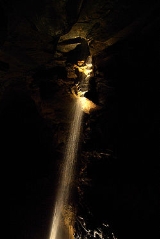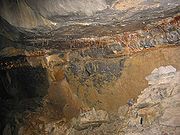
Aillwee Cave
Encyclopedia
Aillwee Cave (Also known as McGanns Cave) is the most famous of the many thousands of ancient caves beneath the karst-landscape
of the Burren
in northwest County Clare
, Ireland
. The name Aillwee is derived from the Irish which means yellow cliff.
s and stalagmite
s. The remains of bears can also be seen inside the caves and allusions have been made to it being the last bear den in Ireland. Roughly 300 meters of cave passage is open to the public, one third of the total length of the cave. The tours end at a point called the highway and exit the cave via a 250 meter manmade tunnel. The cave is typical of the Clare caves, consisting in the main of stream passage and ending in a sump. The general direction is east-west but turns due south some 600 meters into the cave.
The cave is considerably older than most of the Clare caves and originally contained a large stream. The cave is now largely deserted of the stream and is heavily backfilled with glacial infill. The formations visible on the show cave tour are rarely more than 8000 years old but calcite samples in the recesses of the cave have been dated to over 350,000 years old.
 It was discovered in 1944, when a farmer named Jacko McGann followed his dog who was chasing a rabbit. The farmer did not explore very far into the caves, and did not tell anyone of the find for nearly 30 years. He told cavers of the cave in 1973 and that summer the cave was explored as far as a boulder choke. Show cave development began quite soon after. The boulder choke was removed in 1977 and access was gained to the rest of the cave. The Marine Blast tunnel was completed in 1992 to allow a circular trip. The caves are now open daily from 9:30am throughout the year.
It was discovered in 1944, when a farmer named Jacko McGann followed his dog who was chasing a rabbit. The farmer did not explore very far into the caves, and did not tell anyone of the find for nearly 30 years. He told cavers of the cave in 1973 and that summer the cave was explored as far as a boulder choke. Show cave development began quite soon after. The boulder choke was removed in 1977 and access was gained to the rest of the cave. The Marine Blast tunnel was completed in 1992 to allow a circular trip. The caves are now open daily from 9:30am throughout the year.
The caves appear in the Father Ted
episode "The Mainland
" under the name "The Very Dark Caves". They are also mentioned in a story in Part II of The Basset Chronicles by June J. McInerney.
Karst topography
Karst topography is a geologic formation shaped by the dissolution of a layer or layers of soluble bedrock, usually carbonate rock such as limestone or dolomite, but has also been documented for weathering resistant rocks like quartzite given the right conditions.Due to subterranean drainage, there...
of the Burren
The Burren
The Burren is a karst-landscape region or alvar in northwest County Clare, in Ireland. It is one of the largest karst landscapes in Europe. The region measures approximately 250 square kilometres and is enclosed roughly within the circle made by the villages Ballyvaughan, Kinvara, Tubber, Corofin,...
in northwest County Clare
County Clare
-History:There was a Neolithic civilisation in the Clare area — the name of the peoples is unknown, but the Prehistoric peoples left evidence behind in the form of ancient dolmen; single-chamber megalithic tombs, usually consisting of three or more upright stones...
, Ireland
Ireland
Ireland is an island to the northwest of continental Europe. It is the third-largest island in Europe and the twentieth-largest island on Earth...
. The name Aillwee is derived from the Irish which means yellow cliff.
Description
The cave system consists of over a kilometer of passages leading into the heart of the mountain. Its features include an underground river and a waterfall as well as some large stalactiteStalactite
A stalactite , "to drip", and meaning "that which drips") is a type of speleothem that hangs from the ceiling of limestone caves. It is a type of dripstone...
s and stalagmite
Stalagmite
A stalagmite is a type of speleothem that rises from the floor of a limestone cave due to the dripping of mineralized solutions and the deposition of calcium carbonate. This stalagmite formation occurs only under certain pH conditions within the underground cavern. The corresponding formation on...
s. The remains of bears can also be seen inside the caves and allusions have been made to it being the last bear den in Ireland. Roughly 300 meters of cave passage is open to the public, one third of the total length of the cave. The tours end at a point called the highway and exit the cave via a 250 meter manmade tunnel. The cave is typical of the Clare caves, consisting in the main of stream passage and ending in a sump. The general direction is east-west but turns due south some 600 meters into the cave.
The cave is considerably older than most of the Clare caves and originally contained a large stream. The cave is now largely deserted of the stream and is heavily backfilled with glacial infill. The formations visible on the show cave tour are rarely more than 8000 years old but calcite samples in the recesses of the cave have been dated to over 350,000 years old.
Discovery and exploration

The caves appear in the Father Ted
Father Ted
Father Ted is a comedy series set in Ireland that was produced by Hat Trick Productions for British broadcaster Channel 4. Written jointly by Irish writers Arthur Mathews and Graham Linehan and starring a predominantly Irish cast, it originally aired over three series from 21 April 1995 until 1 May...
episode "The Mainland
The Mainland (Father Ted)
"The Mainland" is an episode of the Channel 4 sitcom Father Ted. It was first broadcast on 3 April 1998 as the fourth episode of the third series.-Synopsis:...
" under the name "The Very Dark Caves". They are also mentioned in a story in Part II of The Basset Chronicles by June J. McInerney.

